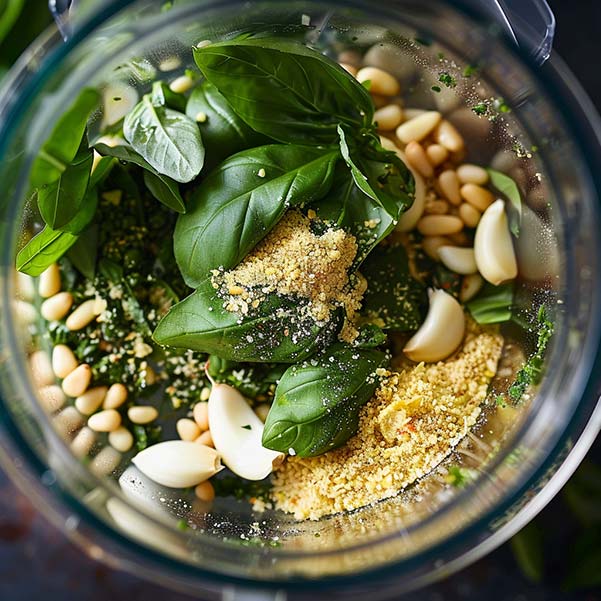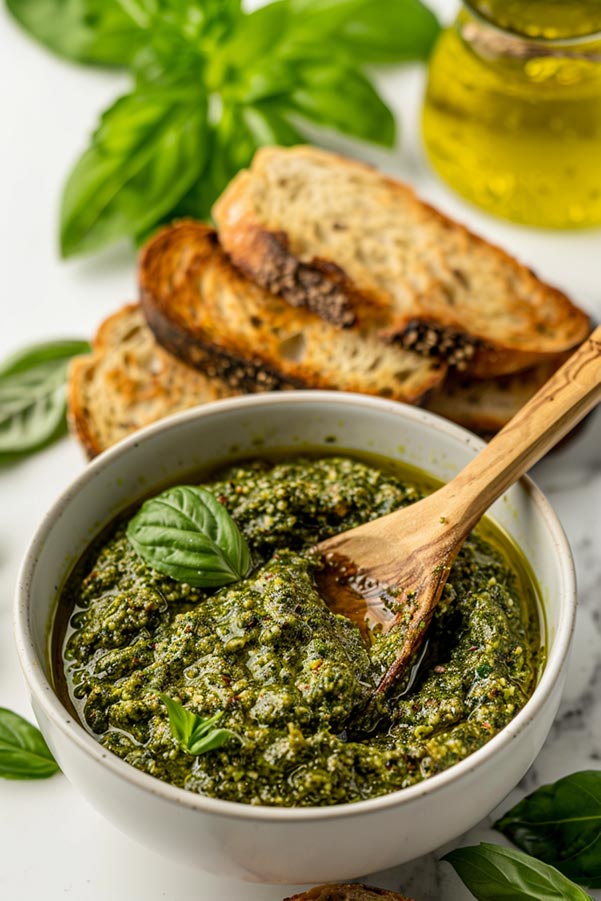Pesto is a versatile and aromatic sauce that captures the essence of fresh herbs, rich nuts, and pungent garlic, all melded together with the luxuriousness of olive oil and the tangy bite of aged cheese. Originating from the picturesque Ligurian coast of Italy, pesto has won the hearts of food enthusiasts worldwide, becoming a staple in kitchens for its simple preparation and depth of flavor.
But what if you're following a vegan lifestyle or simply looking to explore plant-based alternatives? Fear not! Embracing a vegan diet doesn't mean compromising on taste. In fact, vegan pesto opens a new world of possibilities, offering a creative and compassionate twist to this beloved dressing, spread, dip, and pasta sauce.
In this post, I will share how to make a delicious and easy vegan basil pesto version of pesto alla Genovese.
Homemade Pesto Recipe
Prep Time
10 minutes
Cook Time
5 minutes
Rest Time
0 minutes
Total Time
15 minutes
Ingredients
Directions
1. Begin by toasting the pine nuts in a skillet over medium heat, stirring occasionally until they become golden brown and emit a delightful nutty fragrance. Subsequently, take them off the heat and allow them to cool.
2. Incorporate the toasted pine nuts, basil leaves, minced garlic, nutritional yeast, and lemon juice into a food processor, blender, or immersion blender cup. Pulse the mixture several times until the ingredients are coarsely chopped and well-blended.

3. Gradually pour the olive oil in a steady stream while the food processor or blender operates. This helps emulsify the pesto and create a smooth consistency. Keep blending until the mixture achieves the texture that suits your preference.
4. Sample the pesto and season it with salt and pepper to your liking. Give it a final blend to incorporate the seasoning.
5. Move the vegan pesto sauce into a jar or airtight container for storage. If you're not using it immediately, cover the surface of the pesto with a thin layer of olive oil to prevent oxidation and preserve its vibrant green color. You can refrigerate it for up to one week for storage.
Tips & Notes
Use fresh and high-quality ingredients: Pesto relies heavily on the flavor of fresh basil leaves, so make sure to use vibrant, fragrant leaves. Additionally, opt for raw cashews or pine nuts that are not stale or rancid, as they can impact the overall taste of the sauce.
Toast the nuts: Toasting the cashews or pine nuts before blending them adds a delightful nuttiness and enhances their flavor. Monitor them closely during the toasting process, as they tend to burn quickly. Stir them frequently and remove them from heat once they turn golden brown.
For a thicker pesto sauce, reduce the amount of olive oil. Conversely, incorporate a little more oil if you desire a creamier texture. Adjust the quantity according to your preference and the intended purpose of the sauce.
Nutritional Facts
Nutrition Facts
Servings: 4
Calories
250
% Daily Value*
Total Fat 24.6g
32%
Saturated Fat 2.7g
13%
Cholesterol 0mg
0%
Sodium 4mg
0%
Total Carbohydrate 6.9g
3%
Dietary Fiber 2.5g
9%
Total Sugars 1g
Protein 5.3g
Vitamin D 0mcg
0%
Calcium 36mg
3%
Iron 2mg
14%
Potassium 286mg
6%
*The % Daily Value (DV) tells you how much a nutrient in a food serving contributes to a daily diet. 2,000 calorie a day is used for general nutrition advice.
What Ingredients You Need To Make This Vegan Pesto Recipe
Fresh Basil Leaves
Basil is a fragrant herb widely used in Italian cuisine. Its unique fragrance and taste give pesto sauce a refreshing and subtly sweet element. The bright green color of the basil leaves is visually appealing and signifies freshness and vibrancy in the dish.
Raw Pine Nuts
Pine nuts are commonly used in pesto recipes, as they provide a creamy texture and contribute to the sauce's overall richness. Alternatively, cashews or other types of nuts can be used as well. Cashews taste slightly buttery, while pine nuts have a delicate and slightly resinous flavor. They add a subtle nuttiness that complements the basil and other ingredients.
Garlic
Garlic is an essential component in numerous savory dishes, including pesto sauce. Its pungent and savory flavor infuses the sauce with depth and complexity. Garlic releases its unique aroma when minced or crushed, adding a distinctive kick to the pesto.
Nutritional Yeast
Nutritional yeast, a deactivated yeast, is commonly utilized as a vegan alternative to cheese. Its savory, cheesy, and slightly nutty flavor brings an umami element to the pesto sauce. Nutritional yeast is also a great source of B vitamins and protein, making it a nutritious addition to the recipe.
Fresh Lemon Juice
The tartness of freshly squeezed lemon juice imparts a zesty and vibrant touch to the pesto sauce. It aids in harmonizing the richness of the nuts and oil while elevating the overall flavors. The natural citric acid in lemon juice also acts as a preservative, helping to maintain the vibrant green color of the basil.
Extra Virgin Olive Oil
Olive oil is a key ingredient in pesto, providing a smooth and velvety texture to the sauce. Extra virgin olive oil, obtained from the initial pressing of olives, is renowned for its fragrant fruitiness and robust flavor. It not only adds richness but also brings its own unique character to the pesto.
Salt And Pepper
Salt and pepper play indispensable roles as seasonings, amplifying the flavors of the remaining ingredients in the pesto sauce. Salt aids in harmonizing the tastes and accentuating the natural flavors of the basil and nuts. On the other hand, freshly ground black pepper contributes a touch of spiciness and intricate depth to the sauce.
How To Elevate Vegan Pesto Sauce
Roasted Garlic
Rather than using raw garlic, consider roasting the garlic cloves before incorporating them into the pesto. Roasting garlic mellows its flavor, giving it a sweet and caramelized taste. Roasted garlic adds depth and complexity to the sauce, making it even more irresistible.
Toasted Seeds
Add a crunchy element to your pesto by toasting various seeds, such as sunflower seeds, pumpkin seeds, or sesame seeds. Toasting the seeds enhances their nutty flavors and adds a delightful texture to the sauce. You can either replace some of the nuts with seeds or include them alongside them for a unique twist.
Fresh Herbs
While basil is the classic herb used in pesto, don't be afraid to experiment with other fresh herbs to add complexity and depth to your sauce. Consider incorporating herbs like parsley, cilantro, mint, or even arugula. Combining different herbs can create exciting flavor profiles and add a unique touch to your vegan pesto.
Citrus Zest
Enhance the brightness of the pesto by adding citrus zest to the mixture. Grate the zest of a lemon, lime, or orange and mix it in with the other ingredients. The citrus zest adds a fresh and tangy flavor, elevating the overall taste of the pesto.
Nutritional Boosters
Incorporate nutritional powerhouses like flaxseed meal, hemp seeds, or chia seeds to give your pesto extra nutrients. These ingredients boast high omega-3 fatty acids, fiber, and protein levels. Adding them not only enhances the sauce's nutritional profile but also adds a subtle nutty flavor and interesting texture.
Dried Or Sun-Dried Tomatoes
Include dried or sun-dried tomatoes in your pesto sauce for a savory and intense twist. These tomatoes have a concentrated flavor that adds depth and a slightly tangy note to the sauce. Before adding them to the blender or food processor, soak them in warm water to soften.
Frequently Asked Questions (FAQ)
How To Store Leftover Pesto
Once your pesto is prepared, transfer it to a clean, airtight container. When storing pesto, opt for glass jars or containers with a secure lid, ensuring the container is clean and dry before introducing the sauce.
Drizzle a thin layer of olive oil over the sauce to maintain the pesto's vibrant green hue and prevent oxidation. This creates a barrier that seals out air and helps maintain freshness. Ensure the pesto is completely covered with oil, leaving no air gaps.
Put the container of vegan pesto in the refrigerator. The cool temperature helps extend its shelf life and preserve its flavors. When stored correctly, vegan pesto can remain fresh in the refrigerator for up to one week.
If you wish to store the pesto for an extended duration, freezing is a suitable option. For convenience, portion the pesto into smaller airtight containers or ice cube trays and make pesto cubes. When you're ready to use it, thaw the pesto in the refrigerator or at room temperature, and be sure to stir it thoroughly before serving.
Is Traditional Pesto Vegan?
Traditional pesto sauce commonly incorporates Parmesan cheese, derived from animal milk, rendering it unsuitable for a vegan diet. However, with a few modifications, pesto can easily be made vegan-friendly. In a vegan pesto recipe, the Parmesan cheese is omitted or replaced with a vegan alternative or nutritional yeast, which provides a similar cheesy flavor. The remaining ingredients—such as basil, garlic, nuts or seeds, olive oil, and lemon juice—are all plant-based. By substituting or omitting animal-derived ingredients, vegan pesto can be enjoyed by those following a vegan lifestyle.
Can I Use A Different Nut Instead Of Cashews Or Pine Nuts?
Certainly, feel free to explore various nuts like almonds, walnuts, or even sunflower seeds to craft your own vegan pesto. Each nut will bring its unique flavor profile to the sauce, so feel free to explore and find your preferred combination.
Is Nutritional Yeast Necessary For Vegan Pesto?
Nutritional yeast adds a cheesy and slightly nutty flavor to the pesto, mimicking the taste of Parmesan cheese. Nevertheless, if you don't have nutritional yeast or choose to exclude it, rest assured that you can still create a delightful vegan pesto without it. The other ingredients will contribute their own flavors, resulting in a tasty sauce.
Can I Freeze Vegan Pesto?
You can freeze vegan pesto for extended storage. Divide the pesto into smaller airtight containers or ice cube trays, leaving some space at the top to accommodate expansion. When ready to use, thaw the pesto in the refrigerator or at room temperature and stir it before serving.
Can I Use Lemon Juice Instead Of Olive Oil To Make A Lower-Fat Pesto?
While olive oil contributes to the texture and richness of pesto, you can experiment with using a bit more lemon juice or even a splash of water to reduce the amount of oil in the recipe. This can result in a lighter and lower-fat version of vegan pesto.
Can I Make Nut-Free Pesto?
Absolutely! If you have a nut allergy or simply prefer to abstain from nuts entirely, you can replace them with toasted sunflower or pumpkin seeds. They provide a similar nutty texture and can be a delicious alternative.
Can I Use Vegan Pesto For Cooking Or Baking?
Vegan pesto can be a versatile ingredient in cooking and baking. It is perfect for a classic vegan or delicious pesto pasta salad. But it can also be used as a sauce for pizza, spread on sandwiches or wraps, mixed into dips, or added to roasted vegetables and grain bowls. It can also be thinned out with additional oil and used as a salad dressing.


